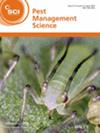求助PDF
{"title":"基于杀虫基因关联分析鉴定苏云金芽孢杆菌高毒株系的生物标志物","authors":"Guoli Xu, Zeyu Wang, Yuqi Bai, Neil Crickmore, Kui Wang, Ahmed Idris Hassen, Lili Geng, Changlong Shu, Jie Zhang","doi":"10.1002/ps.8276","DOIUrl":null,"url":null,"abstract":"BACKGROUND<jats:italic>Bacillus thuringiensis</jats:italic> (Bt) is a Gram‐positive bacterium that produces various insecticidal proteins used to control insect pests. <jats:italic>Spodoptera frugiperda</jats:italic> is a global insect pest which causes serious damage to crops, but bio‐insecticides currently available to control this pest have limited activity and so new ones are always being sought. In this study we have tested the hypothesis that a biomarker for strain toxicity could be found that would greatly facilitate the identification of new potential products.RESULTSUsing genomic sequencing data we constructed a linkage network of insecticidal genes from 1957 Bt genomes and found that four gene families, namely <jats:italic>cry1A</jats:italic>, <jats:italic>cry1I</jats:italic>, <jats:italic>cry2A</jats:italic> and <jats:italic>vip3A</jats:italic>, showed strong linkage. For 95 strains isolated from soil samples we assayed them for toxicity towards <jats:italic>S. frugiperda</jats:italic> and for the presence of the above gene families. All of the strains that showed high toxicity also contained a member of the <jats:italic>vip3A</jats:italic> gene family. Two of them were more toxic than a commercially available strain and genomic sequencing identified a number of potentially novel toxin‐encoding genes.CONCLUSIONSThe presence of a <jats:italic>vip3A</jats:italic> gene in the genome of a Bt strain proved to be a strong indicator of toxicity towards <jats:italic>S. frugiperda</jats:italic> validating this biomarker approach as a strategy for future discovery programs. © 2024 Society of Chemical Industry.","PeriodicalId":218,"journal":{"name":"Pest Management Science","volume":null,"pages":null},"PeriodicalIF":3.8000,"publicationDate":"2024-06-28","publicationTypes":"Journal Article","fieldsOfStudy":null,"isOpenAccess":false,"openAccessPdf":"","citationCount":"0","resultStr":"{\"title\":\"Identification of a biomarker for Bacillus thuringiensis strains with high toxicity against Spodoptera frugiperda based on insecticidal gene linkage analysis\",\"authors\":\"Guoli Xu, Zeyu Wang, Yuqi Bai, Neil Crickmore, Kui Wang, Ahmed Idris Hassen, Lili Geng, Changlong Shu, Jie Zhang\",\"doi\":\"10.1002/ps.8276\",\"DOIUrl\":null,\"url\":null,\"abstract\":\"BACKGROUND<jats:italic>Bacillus thuringiensis</jats:italic> (Bt) is a Gram‐positive bacterium that produces various insecticidal proteins used to control insect pests. <jats:italic>Spodoptera frugiperda</jats:italic> is a global insect pest which causes serious damage to crops, but bio‐insecticides currently available to control this pest have limited activity and so new ones are always being sought. In this study we have tested the hypothesis that a biomarker for strain toxicity could be found that would greatly facilitate the identification of new potential products.RESULTSUsing genomic sequencing data we constructed a linkage network of insecticidal genes from 1957 Bt genomes and found that four gene families, namely <jats:italic>cry1A</jats:italic>, <jats:italic>cry1I</jats:italic>, <jats:italic>cry2A</jats:italic> and <jats:italic>vip3A</jats:italic>, showed strong linkage. For 95 strains isolated from soil samples we assayed them for toxicity towards <jats:italic>S. frugiperda</jats:italic> and for the presence of the above gene families. All of the strains that showed high toxicity also contained a member of the <jats:italic>vip3A</jats:italic> gene family. Two of them were more toxic than a commercially available strain and genomic sequencing identified a number of potentially novel toxin‐encoding genes.CONCLUSIONSThe presence of a <jats:italic>vip3A</jats:italic> gene in the genome of a Bt strain proved to be a strong indicator of toxicity towards <jats:italic>S. frugiperda</jats:italic> validating this biomarker approach as a strategy for future discovery programs. © 2024 Society of Chemical Industry.\",\"PeriodicalId\":218,\"journal\":{\"name\":\"Pest Management Science\",\"volume\":null,\"pages\":null},\"PeriodicalIF\":3.8000,\"publicationDate\":\"2024-06-28\",\"publicationTypes\":\"Journal Article\",\"fieldsOfStudy\":null,\"isOpenAccess\":false,\"openAccessPdf\":\"\",\"citationCount\":\"0\",\"resultStr\":null,\"platform\":\"Semanticscholar\",\"paperid\":null,\"PeriodicalName\":\"Pest Management Science\",\"FirstCategoryId\":\"97\",\"ListUrlMain\":\"https://doi.org/10.1002/ps.8276\",\"RegionNum\":1,\"RegionCategory\":\"农林科学\",\"ArticlePicture\":[],\"TitleCN\":null,\"AbstractTextCN\":null,\"PMCID\":null,\"EPubDate\":\"\",\"PubModel\":\"\",\"JCR\":\"Q1\",\"JCRName\":\"AGRONOMY\",\"Score\":null,\"Total\":0}","platform":"Semanticscholar","paperid":null,"PeriodicalName":"Pest Management Science","FirstCategoryId":"97","ListUrlMain":"https://doi.org/10.1002/ps.8276","RegionNum":1,"RegionCategory":"农林科学","ArticlePicture":[],"TitleCN":null,"AbstractTextCN":null,"PMCID":null,"EPubDate":"","PubModel":"","JCR":"Q1","JCRName":"AGRONOMY","Score":null,"Total":0}
引用次数: 0
引用
批量引用


